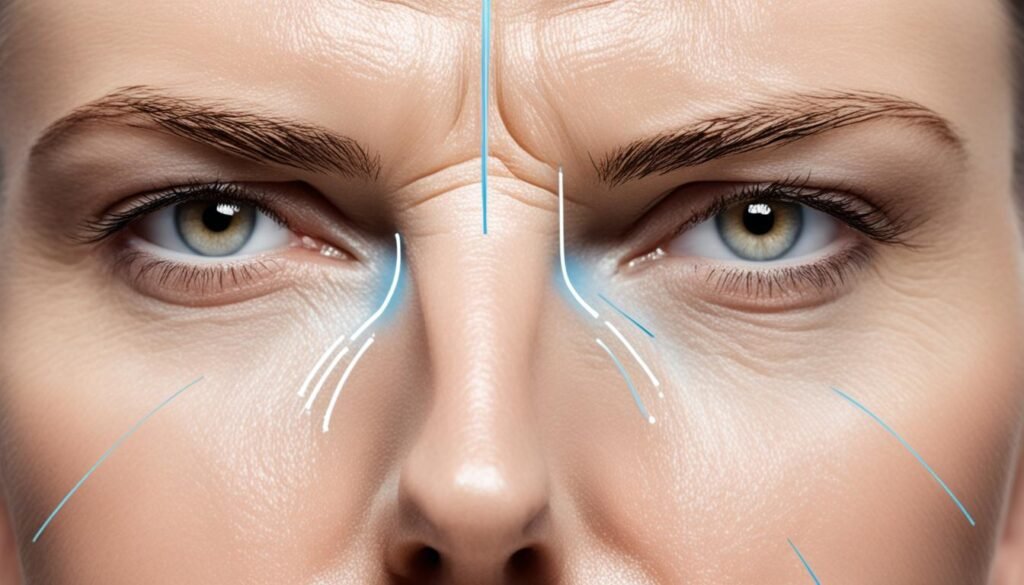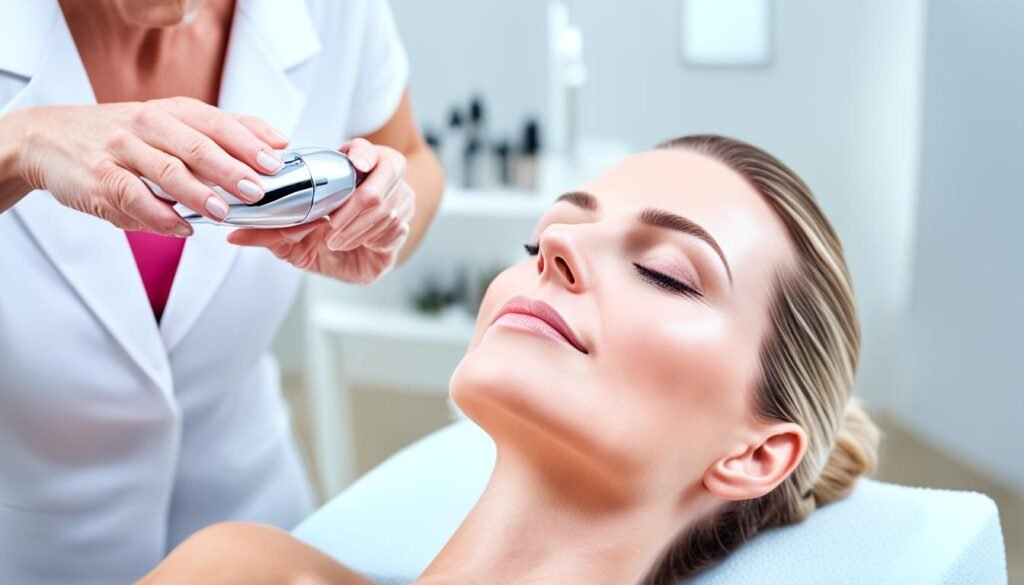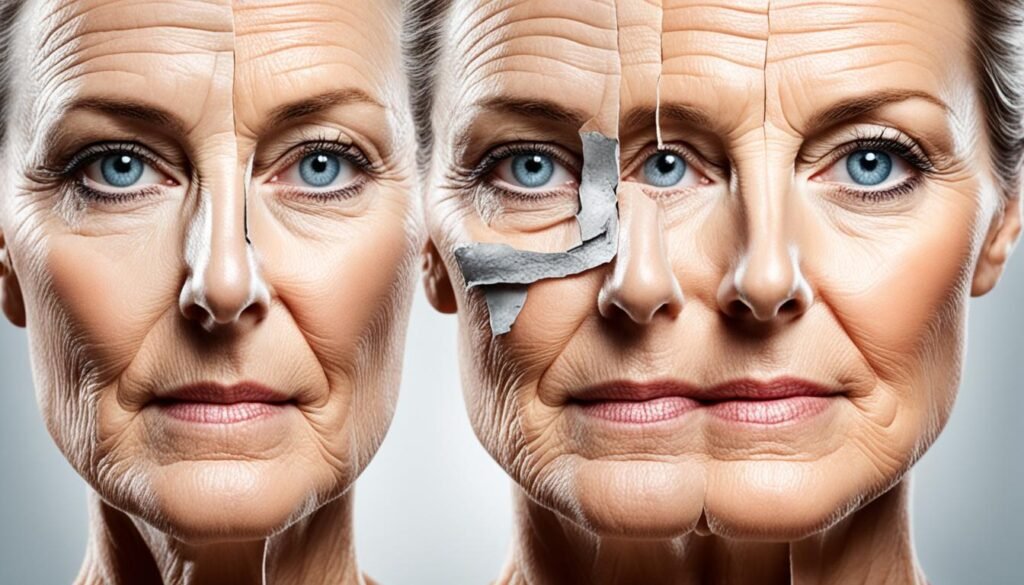The impact of stress on our overall well-being is well known, but did you know that it can also take a toll on our skin? In fact, chronic stress has been found to accelerate the aging process, leading to the formation of stress lines and wrinkles. These visible signs of stress can be frustrating, but the good news is that there are effective strategies for managing stress and minimizing its effects on our skin.
Key Takeaways:
- Chronic stress can contribute to the breakdown of collagen and elastin, resulting in the formation of stress lines and wrinkles in the skin.
- Common areas for stress lines include the forehead and between the eyebrows.
- At-home treatments, such as incorporating retinol and antioxidants into your skincare routine, can help reduce the appearance of stress lines.
- Professional treatments like injectables and microneedling can also be effective in minimizing stress lines.
- Preventive measures, such as stress management techniques and a holistic approach to skincare, are key in preventing and reducing stress wrinkles.
Causes of Stress Lines
Stress lines, similar to other wrinkles, are the result of both intrinsic and extrinsic factors. The natural aging process contributes to the formation of stress lines as the body produces less collagen and elastin over time. Additionally, external factors such as sun exposure, smoking, and chronic stress can also play a role in the development of wrinkles. Chronic stress, in particular, leads to elevated cortisol levels which can break down collagen and elastin, further contributing to the appearance of stress lines. It is crucial to address both intrinsic and extrinsic factors in order to effectively manage and minimize the appearance of stress lines on the skin.
By understanding the causes of stress lines, we can take proactive steps towards preventing and reducing their appearance. Let’s explore these causes further:
Intrinsic Factors
Intrinsic factors refer to the natural aging process that occurs within the body. As we age, our skin undergoes changes, including the production of less collagen and elastin. These proteins are responsible for maintaining the skin’s elasticity and firmness. As their production declines, the skin becomes more prone to wrinkles and sagging, including stress lines.
Extrinsic Factors
Extrinsic factors are external influences that can contribute to the formation of stress lines. Sun exposure, for instance, can accelerate the aging process and lead to the breakdown of collagen and elastin fibers in the skin. Smoking is another extrinsic factor that can cause oxidative stress and damage collagen, leading to the formation of wrinkles. Chronic stress, characterized by elevated cortisol levels, further exacerbates the breakdown of collagen and elastin, resulting in stress lines on the skin.
Chronic stress leads to elevated cortisol levels, which can break down collagen and elastin, leading to the development of stress lines.
Addressing both intrinsic and extrinsic factors is essential in managing and minimizing the appearance of stress lines. Combining effective skincare practices with stress-management techniques can help promote healthier, more youthful-looking skin.
| Intrinsic Factors | Extrinsic Factors |
|---|---|
| – Natural aging process | – Sun exposure |
| – Decreased collagen and elastin production | – Smoking |
| – Chronic stress |
To better understand the causes of stress lines, let’s take a closer look at how each factor contributes to their development:
- Natural aging process: As we age, the body naturally produces less collagen and elastin, which are essential for maintaining the skin’s elasticity and firmness. This decrease in production can lead to the formation of stress lines.
- Sun exposure: Excessive sun exposure can speed up the aging process and damage the skin’s collagen and elastin fibers. Over time, this can contribute to the development of stress lines.
- Smoking: Smoking introduces harmful toxins into the body, which can cause oxidative stress and damage collagen. This can result in the appearance of stress lines.
- Chronic stress: Chronic stress causes the body to release elevated levels of cortisol, a stress hormone. This can break down collagen and elastin, leading to the formation of stress lines on the skin.
By addressing both intrinsic and extrinsic factors, we can take proactive steps towards managing and minimizing the appearance of stress lines. Implementing a comprehensive skincare routine and adopting stress-management techniques can help promote healthier, more youthful-looking skin.
Common Areas for Stress Lines

Stress lines can appear in various areas of the face, depending on where individuals tend to tense their muscles during times of stress. Common areas for stress lines include the forehead and between the eyebrows. These areas are often associated with repetitive muscle movement, such as furrowing the eyebrows or raising the forehead in response to stress.
By targeting these specific areas, individuals can focus on minimizing and preventing the appearance of stress lines in their skincare routine.
Why Are the Forehead and Eyebrows Common Areas for Stress Lines?
The forehead and between the eyebrows are significant areas for stress lines due to the high muscle activity observed during stressful situations. When we furrow our eyebrows or raise our forehead, the repetitive muscle movement can lead to the development of stress lines over time.
“The repetitive contraction and relaxation of facial muscles during heightened stress can result in the formation of stress lines on the forehead and between the eyebrows.”
These areas are also more prone to stress lines because they are more exposed to external factors like sunlight and pollution, which can further contribute to skin damage and accelerated aging.
To effectively address stress lines in these areas, it is essential to incorporate targeted skincare routines and treatments that focus on reducing muscle tension, promoting collagen production, and protecting the skin from environmental stressors.
At-Home Treatments for Stress Lines
Minimizing stress lines doesn’t always require a trip to the dermatologist. Incorporating certain treatments into your at-home skincare routine can help reduce the appearance of stress lines and promote smoother, more youthful-looking skin.
Retinol: Stimulate Cell Turnover and Collagen Production
One effective at-home treatment for stress lines is retinol. Retinol is a form of vitamin A that promotes skin-cell turnover, stimulates collagen production, and helps improve the overall texture and elasticity of the skin. Incorporating a retinol serum into your nighttime skincare routine can contribute to a more youthful complexion.
Sunscreen: Protect Your Skin from Further Damage
Using broad-spectrum sunscreen with at least SPF 30 is another crucial step in reducing stress lines. Sun exposure can exacerbate the signs of aging, leading to the development of fine lines and wrinkles. By applying sunscreen daily, you can protect your skin from harmful UV rays and prevent further damage.
Antioxidants: Prevent Free-Radical Damage
Antioxidants play a vital role in maintaining the health of your skin. They help combat free-radical damage and stimulate collagen synthesis, keeping your skin looking youthful and radiant. Incorporate antioxidant-rich products, such as vitamin C serums, into your skincare routine to help prevent stress lines and promote overall skin health.
A Holistic Approach to Skincare
Remember, skincare is not just about the products you use but also about adopting a holistic approach to your overall well-being. Managing stress through techniques like meditation, exercise, and maintaining a balanced lifestyle can contribute to healthier, more resilient skin. By combining at-home treatments with stress management strategies, you can effectively minimize the appearance of stress lines and promote a more youthful complexion.
Professional Treatments for Stress Lines

While at-home treatments can be effective for minimizing stress lines, there are also various professional treatments available that can provide more targeted and dramatic results. These professional treatments are often performed by dermatologists or aesthetic specialists and offer advanced solutions for reducing the appearance of stress lines on the skin.
Injectables
One of the most popular professional treatments for stress lines is the use of injectables such as Xeomin, Botox, or Dysport. These injectables contain botulinum toxin, which works by temporarily relaxing the muscles responsible for creating the stress lines. By inhibiting muscle movement, injectables can effectively smooth the appearance of stress lines and wrinkles, providing a more youthful and refreshed look.
Microneedling with Platelet-Rich Plasma (PRP)
Microneedling, combined with platelet-rich plasma (PRP), is another professional treatment option for minimizing stress lines. Microneedling involves using tiny needles to create controlled micro-injuries in the skin, stimulating the production of collagen and elastin. The addition of PRP, derived from the patient’s own blood, enhances the rejuvenating effects of microneedling, promoting skin healing and collagen synthesis. This combination treatment can help improve the texture and overall appearance of the skin, reducing the visibility of stress lines.
Radiofrequency Treatments
Radiofrequency treatments, such as Thermage, utilize heat energy to tighten the skin and improve its texture. These treatments work by stimulating collagen production and remodeling, leading to firmer, smoother skin. By targeting the areas with stress lines, radiofrequency treatments can help reduce their visibility and create a more youthful appearance.
Resurfacing Lasers
Resurfacing lasers, like Fraxel, are commonly used in professional settings to address a range of skin concerns, including stress lines. These lasers work by creating controlled damage in the skin, triggering the body’s natural healing response and stimulating collagen production. As the skin repairs itself, it becomes smoother, tighter, and more vibrant, minimizing the appearance of stress lines.
Prescription Retinoids
Prescription retinoids, such as tretinoin or adapalene, can be prescribed by a dermatologist to treat stress lines. Retinoids are vitamin A derivatives that work by increasing cell turnover and stimulating collagen production. These potent treatments can help improve skin texture, reduce fine lines and wrinkles, and diminish the visibility of stress lines over time.
It’s important to consult with a dermatologist or skincare professional to determine the most suitable professional treatment for minimizing your specific stress lines. They can assess your skin condition, discuss your goals, and recommend the most appropriate treatment plan to help you achieve a smoother, more youthful complexion.
Preventing Stress Wrinkles
While it may be challenging to completely eliminate stress from our lives, there are several strategies for preventing stress wrinkles. Managing stress through activities like yoga and meditation can help reduce cortisol levels and promote a sense of calm. Additionally, taking good care of the skin through meticulous sun protection, avoiding smoking, getting enough sleep, and using topical vitamin C serums and retinoids can all contribute to reducing the risk of stress line formation. It is important to prioritize a holistic approach that combines stress management techniques with skincare routines for optimal results.
By incorporating these strategies into our daily lives, we can effectively minimize the appearance of stress wrinkles and maintain a youthful and radiant complexion. Prevention is key when it comes to maintaining healthy skin, and taking proactive steps to manage stress and care for our skin can go a long way in preventing the formation of stress wrinkles.
| Prevention Strategies for Stress Wrinkles | Description |
|---|---|
| Yoga and Meditation | Reduce cortisol levels and promote relaxation. |
| Sun Protection | Wear SPF and protective clothing to shield the skin from UV damage. |
| Avoid Smoking | Smoking accelerates the aging process and contributes to wrinkles. |
| Get Enough Sleep | Adequate sleep allows the skin to regenerate and repair itself. |
| Topical Vitamin C Serums | Vitamin C is a powerful antioxidant that helps protect the skin from free radicals. |
| Retinoids | Retinoids stimulate collagen production and improve skin texture. |
Stress and Skin Aging

Stress can have a significant impact on the aging process of the skin. Long-term high levels of stress can lead to an increase in cortisol levels, which can cause the breakdown of collagen and elastin in the skin. This can result in the formation of wrinkles, fine lines, and a loss of elasticity. Additionally, stress can affect the skin’s overall health and appearance, leading to dullness, dehydration, and an impaired skin barrier function. Managing stress effectively is essential for maintaining youthful and healthy-looking skin.
When stress takes a toll on the skin, it accelerates the aging process, leading to visible signs of premature aging such as wrinkles, fine lines, and a loss of elasticity. The connection between stress and skin aging lies in the hormonal imbalance triggered by stress. Cortisol, also known as the stress hormone, can break down collagen and elastin, which are essential proteins responsible for maintaining the skin’s firmness and elasticity. Furthermore, increased cortisol levels can impair the skin’s ability to retain moisture, resulting in dehydration and dullness.
Table: Effects of Stress on Skin Aging
“`
| Skin Aging Effects of Stress |
|———————————————–|
| ● Formation of wrinkles and fine lines |
| ● Loss of elasticity |
| ● Dullness and dehydration |
| ● Impaired skin barrier function |
“`
Chronic stress can also lead to the overproduction of free radicals, which are unstable molecules that damage healthy skin cells and accelerate the aging process. The combination of reduced collagen and elastin production, impaired moisture retention, and increased free radical damage can contribute to premature skin aging. It is therefore essential to address stress as part of a comprehensive skincare routine to maintain a youthful appearance.
“Stress is not only detrimental to our overall well-being but also has a profound effect on our skin’s health and appearance. By managing stress effectively, we can significantly slow down the aging process and maintain a youthful complexion.”
In addition to managing stress, utilizing skincare products with ingredients that combat the effects of stress on the skin can be beneficial. Antioxidants such as vitamin C and E are known for their ability to neutralize free radicals and protect the skin from oxidative stress. Hyaluronic acid and ceramides can help restore moisture and strengthen the skin barrier, combating dryness and improving elasticity. Nourishing the skin with these key ingredients can aid in maintaining a youthful and healthy complexion in the face of stress.
H3: Lifestyle Tips to Reduce Stress and Promote Youthful Skin
- Practice stress-reducing exercises like yoga or meditation
- Engage in regular physical activity to promote overall well-being
- Maintain a balanced diet rich in antioxidants and essential nutrients
- Ensure an adequate amount of sleep and establish a consistent sleep schedule
- Take time for self-care and engage in activities that bring joy and relaxation
By incorporating stress-management techniques into our daily lives and adopting a skincare routine that targets stress-related skin aging, we can achieve a healthy and youthful complexion that reflects inner well-being.
The Rise of Anti-Stress Skincare

In recent years, there has been a growing trend towards anti-stress skincare products. These products aim to reduce inflammation, repair the skin barrier function, and soothe the outward symptoms of stress on the skin. Ingredients such as ceramides, hyaluronic acid, antioxidants, and peptides are commonly found in anti-stress skincare formulations. Additionally, adaptogens like reishi mushroom, ashwagandha, and turmeric have become popular for their stress-relieving properties. Anti-stress skincare provides a holistic approach to skincare, addressing both the physical and emotional effects of stress on the skin.
Developing an Ideal Skincare Routine for Stressed Skin

Creating an effective skincare routine is essential for addressing the impact of stress on the skin. By incorporating a holistic approach that combines stress management techniques with nourishing skincare products, you can enhance the health and appearance of stressed skin.
To begin with, it’s crucial to address both the internal and external factors that contribute to skin stress. Implement stress-relief techniques like meditation and exercise into your daily routine to promote a sense of calm and reduce cortisol levels. A balanced diet and appropriate supplementation can also support skin health from within.
When it comes to skincare, choose products that prioritize hydration, soothing, and repairing the skin barrier function. Key ingredients that can benefit stressed skin include:
- Ceramides: These lipids help strengthen the skin barrier, improving its ability to retain moisture and protect against environmental stressors.
- Hyaluronic Acid: Known for its ability to hold water, hyaluronic acid helps hydrate and plump the skin, reducing the appearance of fine lines and promoting a more youthful complexion.
- Antioxidants: Look for products containing antioxidants like vitamin C, which can help neutralize free radicals and protect the skin from oxidative stress.
- Peptides: These small chains of amino acids can help stimulate collagen production and improve skin elasticity, reducing the visible signs of stress.
By incorporating these ingredients into your skincare routine, you can support stressed skin and combat the effects of external stressors.
| Skincare Product | Key Ingredients | Benefits |
|---|---|---|
| Hydrating Serum | Ceramides, Hyaluronic Acid | Restores moisture, strengthens the skin barrier |
| Antioxidant Cream | Vitamin C, Green Tea Extract | Protects against free radicals, reduces inflammation |
| Peptide Moisturizer | Peptides, Niacinamide | Stimulates collagen production, improves skin elasticity |
Remember, consistency is key when it comes to skincare routines. Develop a morning and evening routine that includes cleansing, toning, and moisturizing to provide your stressed skin with the care it needs.
Additionally, consider incorporating targeted treatments like facial masks or serums to further address specific concerns, such as redness or dullness caused by stress.
Tip: Don’t forget to consult with a dermatologist or skincare professional to personalize your skincare routine based on your specific skin type and concerns. They can provide expert recommendations and guidance tailored to your individual needs.
By developing an ideal skincare routine for stressed skin, you can effectively manage the impact of stress and promote a more radiant, healthy complexion.
References:
- “Ceramides and Skin Function.” Journal of Clinical Lipidology, Elsevier, Vol. 6, Issue 6, 2012, pp. 495-496.
- Ogawa, Youichi et al. “Hyaluronan in Cancer Biology: A Thorough Review.,” Pharmaceuticals (Basel, Switzerland), MDPI, Vol. 9, Issue 4, 2016, p. 43.
- Pence, Brandt C. et al. “The Role of Oxidative Stress in the Aging Skin,” Handbook of Skin Aging, Springer, 2017, pp. 91-100.
- Varani, James et al. “Beneficial Effects of Sirtuins in Skin After Stress Exposure,” Journal of Cell Science, The Company of Biologists, Vol. 131, Issue 2, 2018, jcs213587.
Conclusion
Stress management is vital for maintaining youthful, healthy-looking skin. By addressing stress lines and wrinkles through a combination of at-home and professional treatments, individuals can minimize their appearance. Implementing preventative measures like diligent sun protection and the incorporation of skincare ingredients such as retinol and antioxidants can also contribute to reducing stress-related skin concerns.
Additionally, the emergence of anti-stress skincare products offers a comprehensive approach to skincare that tackles both the physical and emotional effects of stress on the skin. These products, formulated with ingredients like ceramides, hyaluronic acid, and adaptogens, aim to soothe inflammation, repair the skin barrier, and alleviate the outward symptoms of stress.
To promote a radiant, youthful complexion, it is crucial to develop an ideal skincare routine for stressed skin. This involves focusing on hydration, soothing, and repairing the skin barrier function. Ingredients like ceramides, hyaluronic acid, antioxidants, and peptides can provide beneficial effects. In addition, incorporating stress-relief techniques like meditation and exercise can further enhance the overall health and appearance of stressed skin.
By prioritizing stress management and integrating effective skincare practices, individuals can achieve a rejuvenated complexion and embrace the transformative power of skincare in combating the visible signs of stress on the skin.
FAQ
What causes stress lines?
Stress lines and wrinkles in the skin are caused by a combination of intrinsic and extrinsic factors. Intrinsic factors include the natural aging process, where the body produces less collagen and elastin as we get older. Extrinsic factors, such as chronic stress, can also contribute to the breakdown of collagen and elastin in the skin.
Where are common areas for stress lines?
Stress lines can appear in various areas of the face, depending on where individuals tend to tense their muscles during times of stress. Common areas include the forehead and between the eyebrows, where repetitive muscle movement occurs.
What are some at-home treatments for stress lines?
At-home treatments for stress lines include the use of retinol to stimulate skin-cell turnover and collagen production, along with regular use of broad-spectrum sunscreen and antioxidants like vitamin C serums.
What professional treatments are available for stress lines?
Professional treatments for stress lines include injectables like Xeomin, Botox, or Dysport to relax the muscles, microneedling with platelet-rich plasma (PRP) to stimulate collagen production, and radiofrequency treatments like Thermage to tighten the skin and improve texture. Other options include resurfacing lasers and prescription retinoids.
How can I prevent stress wrinkles?
While it may be challenging to completely eliminate stress from our lives, managing stress through activities like yoga and meditation, taking good care of the skin through meticulous sun protection, avoiding smoking, getting enough sleep, and using topical vitamin C serums and retinoids can all contribute to reducing the risk of stress line formation.
What is the connection between stress and skin aging?
Stress can have a significant impact on the aging process of the skin. Long-term high levels of stress can lead to an increase in cortisol levels, which can cause the breakdown of collagen and elastin in the skin. This can result in the formation of wrinkles, fine lines, and a loss of elasticity.
What is anti-stress skincare?
Anti-stress skincare products aim to reduce inflammation, repair the skin barrier function, and soothe the outward symptoms of stress on the skin. They often contain ingredients such as ceramides, hyaluronic acid, antioxidants, and peptides, as well as adaptogens like reishi mushroom, ashwagandha, and turmeric.
How can I develop an ideal skincare routine for stressed skin?
Developing an ideal skincare routine for stressed skin involves addressing both the internal and external factors that contribute to skin stress. This includes practicing stress-relief techniques, nourishing the skin from within through a balanced diet and appropriate supplementation, and using skincare products that focus on hydration, soothing, and repairing the skin barrier function.




